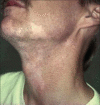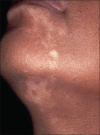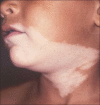Vitiligo: a review of some facts lesser known about depigmentation
- PMID: 21716544
- PMCID: PMC3108518
- DOI: 10.4103/0019-5154.80413
Vitiligo: a review of some facts lesser known about depigmentation
Abstract
Vitiligo is a disorder that causes the destruction of melanocytes. It has three important factors underlying this destruction. The depigmented skin has many aberrant functions such as a muted response to contact allergens, a phenomenon also seen in mice that depigment. The white skin of those with vitiligo does not form non-melanoma skin cancers although the white skin of albinos, which has a similar color as vitiligo, is highly susceptible to skin cancer.
Keywords: Vitiligo; albinos; contact allergen; non-melanoma skin cancer.
Conflict of interest statement
Figures























References
-
- Nordlund JJ, Ortonne JP. Vitiligo vulgaris. In: Nordlund JJ, Hearing VJ, King RA, Oetting W, Ortonne JP, editors. The pigmentary system: Physiology and pathophysiology. Oxford: Blackwell Scientific, Inc; 2006. pp. 591–8.
-
- Hann SK, Nordlund JJ, editors. 1st ed. Oxford, London: Blackwell Science Ltd; 2000. Vitiligo: A Monograph on the Basic and Clinical Science; pp. 1–386.
-
- Ortonne JP, Nordlund J. Mechanisms that cause abnormal skin color. In: Nordlund JJ, Boissey RE, Hearing VJ, King RA, Oetting WS, Ortonne JP, editors. The Pigmentary System: Physiology and Pathophysiology. Oxford: Blackwell Scientific Publishing; 2006. pp. 521–38.
-
- Nordlund JJ, Ortonne J. The normal color of human skin. In: Nordlund JJ, Boissey RE, Hearing VJ, King RA, Oetting WS, Ortonne JP, editors. The Pigmentary System: Physiology and Pathophysiology. Oxford: Blackwell Scientific; 2006. pp. 504–20.
-
- Boissy R, Nordlund JJ. Vitiligo: Current medical and scientific understanding. G Ital Dermatol et Venereol. 2011:46. - PubMed
LinkOut - more resources
Full Text Sources
